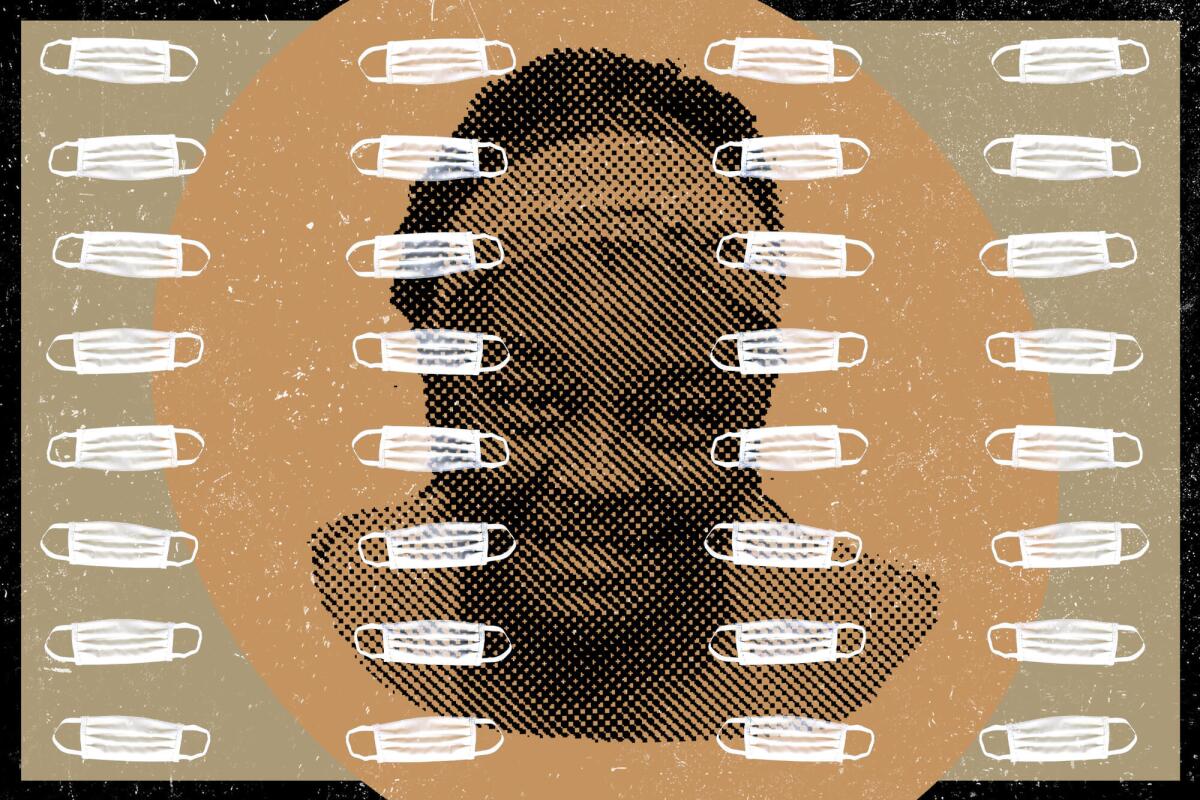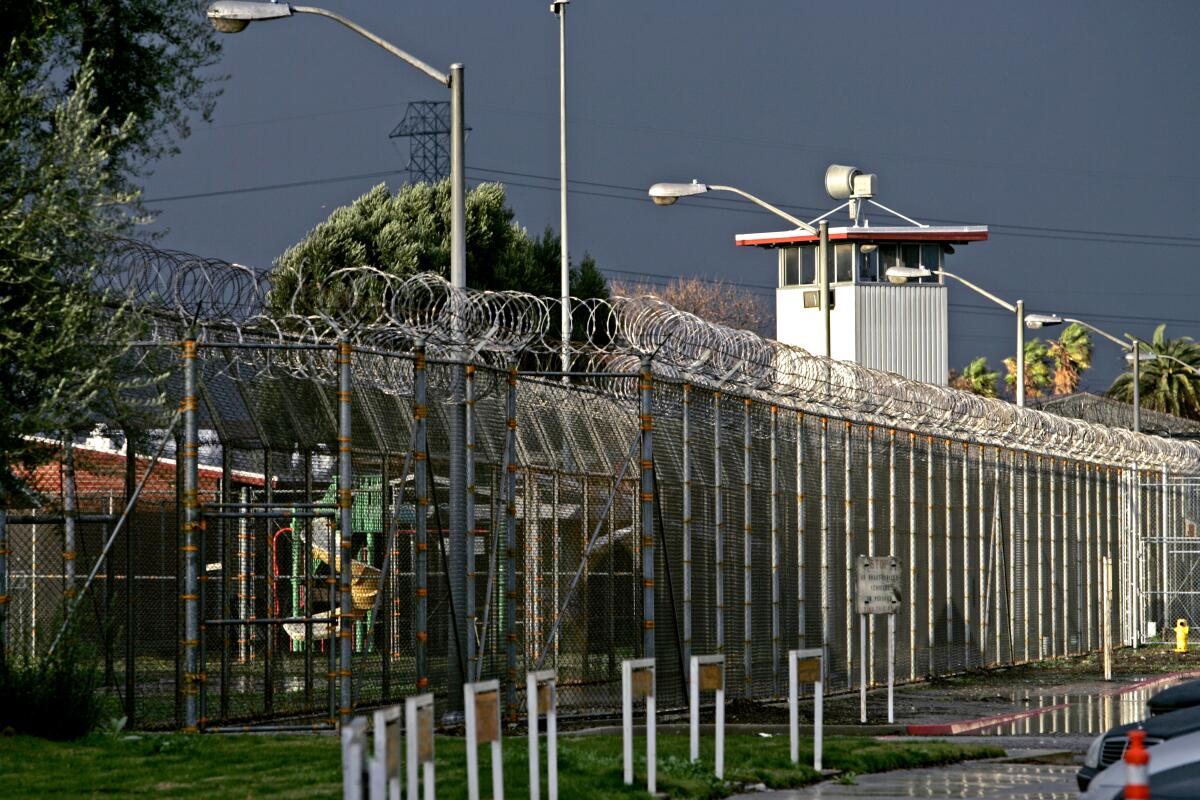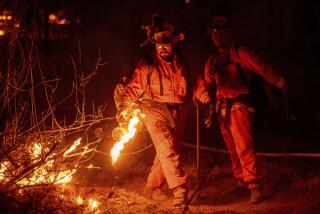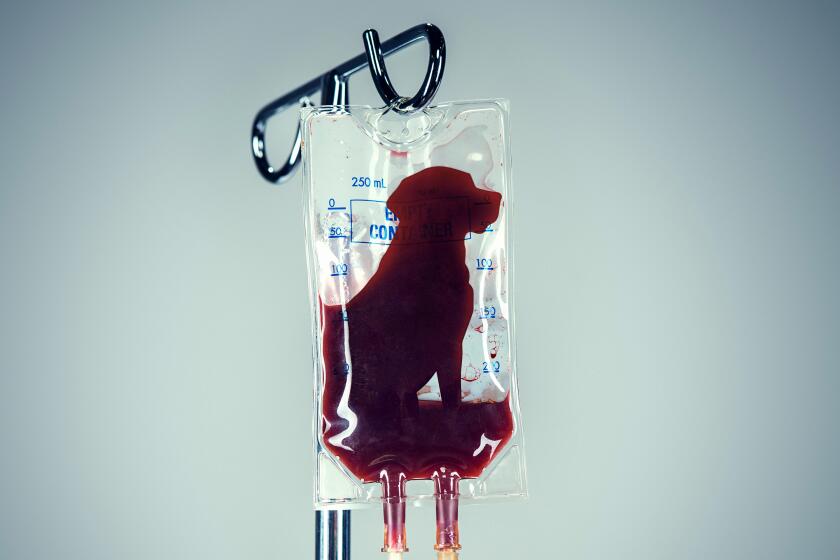California kept prison factories open. Inmates worked for pennies an hour as COVID-19 spread

- Share via
While much of California shut down this spring, Robbie Hall stitched masks for 12 hours a day in a sewing factory at a women’s prison in Chino. For several weeks, Hall and other women said, they churned out masks by the thousands but were forbidden from wearing them.
The incarcerated seamstresses at the California Institution for Women grew increasingly worried: The fabric they used came from the nearby men’s prison, where an outbreak ended up killing 23 inmates. And their boss regularly visited both institutions.
“Are we safe with her going over there and coming back here?” Hall remembered asking her co-workers as they sewed.
Then it happened.
In early May, COVID-19 broke out in the sewing factory, sickening at least four incarcerated workers, including Hall. She spent weeks in the hospital struggling to breathe.
California’s prison system has taken drastic measures to combat the coronavirus, halting rehab programs, religious services and educational classes. But correctional authorities kept one type of operation running through much of the last six months: prison factories.
Hall was one of thousands of incarcerated workers who stayed on the job in high-risk positions during the pandemic, making wages that ranged from 8 cents to $1 an hour. They cooked the food. They walked from cell to cell delivering meals. They cleaned everything from communal showers to COVID-19 units in prison hospitals. And they labored in prison factories making products, such as masks, hand sanitizer and furniture, that were sold to state agencies for millions of dollars.
It was “like a slave factory. The more you give them, the more they want.”
— Robbie Hall
Amid the drive for production, factories continued to operate even as infections increased inside prison walls, according to interviews with more than 30 inmates at the women’s prison in Chino and at Avenal State Prison for men, including some who became infected with the coronavirus. The factories brought together inmates who were housed in different units, heightening the risk of spreading the virus to other areas inside the prisons, The Times found.
Factory staff, they said, warned that workers would lose their jobs — their only source of income — if they missed a day. Some said they were threatened with discipline that could jeopardize their chances for release from prison if they refused to work because of COVID-19 fears.
At the Chino prison, workers said, supervisors kept raising the daily quotas, from 2,000 to 3,000 to 3,500 masks. Seven days a week, the women cranked out masks until their bodies ached, and all they could do at night was collapse asleep in their cells.
It was “like a slave factory,” Hall said. “The more you give them, the more they want.”
The Times sent detailed questions and requested interviews with the heads of state agencies responsible for prison conditions, but officials responded through representatives.
Michele Kane, a spokeswoman for the California Prison Industry Authority, which oversees the factories, said in a statement that “essential critical enterprises,” such as food, laundry and the manufacture of masks and hand sanitizer, have continued operating during the pandemic. The agency acknowledged that goods like furniture were made “when deemed safe” but declined to say what other factories remained open.
Kane said the agency reduced inmate staffing at factories, imposed social distancing and decided when to close or reopen operations in consultation with the corrections department and the court-appointed federal receiver overseeing healthcare inside California’s prisons.
Dana Simas, a spokeswoman for the California Department of Corrections and Rehabilitation, said in a statement that the agency follows isolation and quarantine protocols approved by the federal receiver. The statement said the agency has taken “extraordinary measures to address COVID-19” in prisons, such as providing staff and inmates with protective equipment.
But interviews with incarcerated workers paint a disturbing picture of prison labor during the pandemic: meager wages, questionable infection control and the threat of more time in prison looming over their heads.
Supporters of prison labor say the practice helps defray costs of incarceration, provides job skills and reduces recidivism rates. But legal scholars and civil rights advocates have long criticized prison labor as exploitative and part of the historical legacy of slavery — a deep injustice, they say, only magnified by COVID-19.
“It is a bureaucratic decision to keep people working for pennies an hour during a pandemic,” said Kate Chatfield, director of policy at the Justice Collaborative, a national organization that advocates for criminal justice reform. “This should appall everyone who wants to live in a civilized society.”
::
“Why is money more important than human lives? Inmates are just a business.”
— David Burke, an inmate at Avenal State Prison
The California Prison Industry Authority, a state agency known as CALPIA, oversees roughly 7,000 incarcerated workers statewide. Through CALPIA, prison labor makes everything from U.S. flags, license plates and packaged snickerdoodles to furniture found in the offices of nearly every state agency.
Fabric is CALPIA’s biggest moneymaker in manufacturing, bringing in $23.7 million in revenues in 2019, with furniture not far behind at $16.9 million, according to a recent audit. The state prison system is CALPIA’s biggest customer, accounting for about two-thirds of sales. Other major customers include the DMV, the California Department of Forestry and Fire Protection, and the Department of Health Care Services.
On April 1, the 11-member Prison Industry Board met and agreed to pay prison laborers overtime — though one board member worried that inmates would slow down production “just to get into the overtime.”
CALPIA General Manager Scott Walker acknowledged in the meeting that he couldn’t justify keeping factories open to produce “non-mission-critical” goods like shoes, furniture or snowplows for Caltrans. Walker said he had been “struggling with this for days” as he thought of “requiring people to come to work during this process to build a desk.”
Walker concluded the agency should “maybe err on the side of the medical knowledge and say, ‘Hey, stop. Stop all this nonessential traveling across the yard, commingling in a factory and just run the essential stuff,’” according to a transcript of the meeting.
The furniture factory was closed at Avenal State Prison in Kings County the very next day.
But not for long. The factory was back up and running just 27 days later, on April 29.
The first inmates and staff at Avenal State Prison tested positive for the coronavirus in mid-May.
Around the third week of May, an incarcerated worker in the furniture factory tested positive and was put in isolation, according to two workers who spoke on condition of anonymity for fear of retribution. They had all been exposed to the man, the workers said. But a supervisor announced that if they didn’t report to the factory the next day, they’d get a write-up — a serious form of discipline that is a black mark when petitioning the parole board for release.
“It prevents us from going home early,” one explained. “A bunch of us went back to work. And a bunch of us contracted the virus.” He said he became deathly ill with COVID-19.
Kane, the CALPIA spokeswoman, said the agency had not received complaints alleging furniture factory workers were threatened with discipline for refusing to work during the pandemic.
The factory didn’t shut down until May 28, according to CALPIA. The shutdown came in response to an outbreak on the factory floor, workers said. The factory reopened June 18, Kane said, but then closed for two weeks in July. That was following another outbreak, workers said.
By the end of July, coronavirus cases at the prison had surpassed 1,400 and five inmates had died.
“Why is money more important than human lives?” asked David Burke, who is incarcerated at Avenal State Prison. “Inmates are just a business.”
As chairman of his yard’s Inmate Advisory Council, Burke receives internal reports on prison operations, including coronavirus matters. He said that, as of mid-August, 83% of inmates had been infected with the coronavirus in the yard that staffs the furniture factory. Burke said the prison had increased the risk of spreading the virus in May by allowing workers from four different housing units into the furniture factory after one of them had tested positive.
Even operating with a skeleton crew for half of July, the factory produced more than $300,000 of furniture that month, inmates said.
Kane said the Avenal furniture factory has been working on an order for a substance abuse program that prison officials hope to launch. She said CALPIA currently uses only inmates from housing units where infections were “deemed resolved and workers from the same cohorts who are already living, eating, and recreating together.”
In late September, two more Avenal inmates died at outside hospitals, bringing the total to seven. As of Friday, 296 staffers and 2,931 inmates at the prison had been infected.
::
“I am just trying to make it out alive. I was not sentenced to death in prison.”
— Sheri Hughes, a worker in the Chino prison kitchen
Many legal scholars and civil rights advocates argue that contemporary prison labor is a form of slavery allowed by the 13th Amendment, which banned slavery and involuntary servitude “except as a punishment for crime.” The language was a compromise — a way to preserve slavery in a different configuration, said Michele Goodwin, chancellor’s professor of law at UC Irvine.
“This amendment says, ‘Go at it! It’s OK!’ We have given the state authority to do this form of slavery [in which] people can do unpaid or minimally paid labor,” Goodwin said.
In the decades after the Civil War, Southern states passed laws targeting Black people for frivolous crimes such as vagrancy. Imprisoned in droves, they were forced to work for private industry in coal mines, brickyards, plantations and elsewhere — a “convict-leasing” system under which prison officials often reaped the profits.
Today, racial disparities behind bars remain stark. Black people make up about 6.5% of California’s population but comprised more than 28% of its prisoners at the end of 2018, the most recent date for which figures are available.
By law, “any able-bodied inmate” can be required to “perform any work deemed necessary” for prison operations. Though the prison can take into account individual wishes — for example, a preference for an educational program over work — it doesn’t have to. Once on the job, those who refuse work or fail to perform “within the inmate’s abilities” face disciplinary action, which can lead to denial of parole.
Several prison cleaners and kitchen staffers told The Times they were scared of becoming infected at work but couldn’t jeopardize their release dates.

“I am just trying to make it out alive,” said Sheri Hughes, a worker in the Chino prison kitchen, where inmates come from different housing units and several have become infected with the coronavirus. “I was not sentenced to death in prison.”
Incarcerated workers in California and other states are not classified as employees. They can’t get unemployment, sick leave or paid time off. The pay scale is set by state law, with many jobs paying 8 cents an hour and the CALPIA jobs paying more — from 35 cents to $1 an hour.
Because of the slightly higher starting pay, the factory jobs are sought after, and workers apply for positions. Even so, low wages make it impossible to support family members or build up savings. Many leave prison deeply in debt from court-imposed fees.
The work cooking, cleaning and producing furniture is essential for operating the state’s prisons, which currently confine about 100,000 people at an annual cost of $81,000 each. If incarcerated workers were paid minimum wage, the system as it exists today would collapse, said Chatfield, the policy director at the Justice Collaborative.
“If the price tag got so steep,” she said, “we would really have to reconsider how many people we incarcerate.”
::
Hall, 58, grew up in South Los Angeles and has been in prison for 35 years.
She is serving a 15-year-to-life sentence for murdering a man she says raped her and tried to kill her when she was 23. Since 1994, she has been denied parole repeatedly. Hall would like to hire an attorney to make a renewed case that her crime was in self-defense, but she can’t afford to.
As a child, Hall said, she was physically and sexually abused. In California state prisons, 25% of women are Black, like Hall, according to the corrections department, and 92% have experienced abuse, according to the American Civil Liberties Union.
Before the pandemic, Hall was known in prison as a peer counselor and a church praise dancer, spending her Sundays raising her arms to the sky, leading worshipers in songs that promised a brighter tomorrow.
She is a proud grandmother to eight and a great-grandmother to four, so keeping in touch with family is crucial. But it hasn’t been easy to do that. Sending a single email costs about 26 cents to buy a “stamp” from JPay, the company that runs the system. She also relies on her 60-cent-an-hour wages to pay for basic necessities like soap and food, which are sold at the prison canteen at premium prices.
Hall has held many jobs in prison including kitchen server, ambulance driver and painter.
When the hours at the sewing factory kept getting longer and longer, Hall didn’t object. She and the other workers felt they had little choice. Supervisors told them they’d be replaced if they refused overtime, Hall said.
As March turned into April, prison sewing factories across the state made more than 1.4 million masks. They primarily went to prisons for use by inmates and staffers, but dozens of state agencies also put in orders. At the Correctional Training Facility near Salinas, the sewing factory ran 14 hours a day, seven days a week, according to corrections records.
A number of women who sewed masks in the Chino factory said they felt they were doing important work to help save lives. They were proud of their hard labor, even as they criticized the conditions.
Although CALPIA insisted the agency issued protective equipment from the start, seven incarcerated workers said supervisors told them in the first few weeks that they’d get in trouble for wearing the masks they made. It wasn’t until about mid-April that the whole prison, including the factory, got masks, workers said.
The 40 women who worked in the factory were terrified when they learned of an enormous outbreak that began in March at the nearby California Institution for Men. Among the group was a woman in her 70s who used a walker.
Whenever the truck from the men’s prison arrived with more fabric, the supervisors didn’t want to go anywhere near the driver “because she had been exposed over there,” said Kellie Chivrell, the fabric cutter in the factory.
And so unloading the heavy fabric fell on Chivrell. She said the driver, a CALPIA employee at the men’s prison, never wore a mask and told Chivrell she hadn’t been given any. It wasn’t long before Chivrell tested positive for the coronavirus and spent weeks in the prison infirmary.
At one point, Chivrell said, the prison bungled her test results, mistakenly giving her a negative result and releasing her from isolation. She said she spent 24 hours circulating in the general population before prison staff realized the error. (A corrections department spokesperson declined to comment, citing patient privacy.)
Responding to detailed questions from The Times, a CALPIA representative said overtime hours were voluntary. The spokesperson acknowledged that goods were transported between the prisons and that two managers had visited both institutions in April to provide “critical support,” but the agency denied “the generalization that we had staff continually going back and forth.”
The outbreak at the Chino women’s prison — which has claimed the lives of one inmate and a staffer — can’t be attributed to any one cause. Women in the prison and their advocates have criticized officials for waiting until May to do mass testing, as well as guards’ failure to comply with a statewide mask requirement.
“Put your mask on, sir!” Hall called out to an officer during a phone interview.
Whatever the reason, the sewing factory proved fertile ground for the virus. From there, workers said, COVID-19 spread through the prison.
::
It was a neighbor who found Hall sprawled across the floor in her cell, gasping for breath and unable to talk. She said she flailed her hands trying to signal “222” — prison code for an emergency.
On May 8, paramedics rushed Hall to Riverside Community Hospital. She spent weeks in and out of consciousness, fighting COVID-19-related pneumonia.
When Hall was discharged from the hospital, she returned to prison with an oxygen tank. She had also developed a painful case of shingles and needed a walker to get around.
In total, 352 inmates and 85 staffers have been infected with the coronavirus at the Chino women’s prison. Statewide, prison authorities say they do not track infections of incarcerated workers separately from the general population, so it is unclear how many of the 15,121 inmates who have tested positive worked in factories or other jobs.
To be sure, there are many factors in the spread of COVID-19. State prisons are over capacity, and crowded dorms and cells make social distancing impossible.
“What keeps prisons safer? Having fewer people in them,” said Dr. Stefano Bertozzi, professor of health policy and management at the UC Berkeley School of Public Health. “We need to accelerate releases.”
Although she still had trouble breathing and feared reinfection, Hall needed money for toothpaste and shampoo and tried to return to work one day. But she felt too weak and had to leave.
As temperatures soared this summer inside the non-air-conditioned prison, Hall used the last of her earnings to buy a $49 fan, which broke almost immediately. Without a job, she can’t buy another.
The factory stopped making masks in the spring, workers said. More recently the women have been sewing the orange pants and shirts worn by California’s inmate firefighters.
As Hall sees it, the pandemic only deepened her understanding of the way things are.
The prison system, she said, “keeps us as a money tree.”
More to Read
Sign up for Essential California
The most important California stories and recommendations in your inbox every morning.
You may occasionally receive promotional content from the Los Angeles Times.











